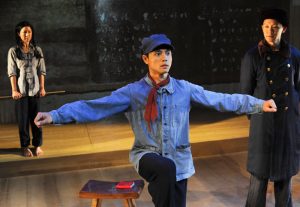The Peasant Prince
 |
| Photo by Heidrun Lohr |
Monkey Baa presents, THE PEASANT PRINCE, by Eva Di Cesare, Sandie Eldridge and Tim McGarry, based on the children’s book, by Li Cunxin, illustrated by Anne Spudvilas, at the Lendlease Darling Quarter Theatre, Darling Harbour, 9-20 April.
THE PEASANT PRINCE, is an adaptation, in book form of Li Cunxin’s MAO’S LAST DANCER, for children, and has served as the inspiration for the Monkey Baa Theatre Company to bring to life on the stage.
It is a rudimentary ‘rags to riches’ story, of a kind of ‘fairytale’ journey of a young Chinese boy from a backwoods Chinese village, in ‘classic’ Mao time – propaganda and all – to the city of Bejing, where he is trained as a classical ballet dancer, who has the further good ‘fate’ to travel to the West, the United States to the Houston Ballet Company, to experience the opportunities it can offer to his life’s destiny.
An all Australian/Asian Company of actors: Jonathan Chan, Jenevieve Chang, John Gomez Goodway and Edric Hong, with many character impersonations, tell the story with charm and engaging personality. The young audience I saw the play with, were engrossed and entertained – especially the young balletomanes, who exercised the barre work with the actors in their seats.
Michael Hankin, has created a large rectangular screen in a handsome wooden frame that allows for the projection of many video images, illustrating the world of Chairman Mao’s China, Designed by David Bergman, that does much in holding the storytelling in fluid and comprehensible action. Daryl Wallis’ music score does much, as well, to support the material and the movement sequences, created by Danielle Micich.
Altogether this is, ultimately, a production that has the charm of design and simple direction of the acting to get it through some cliche storytelling. The story is being told for very young children, and it seems, is sufficient. enough for some. But, when one compares the recent film subject matter of children’s entertainment (INSIDE OUT, ZOOTOPIA) the content of this work and the way it is told may be underestimating the ‘sophistication’ of its audience.